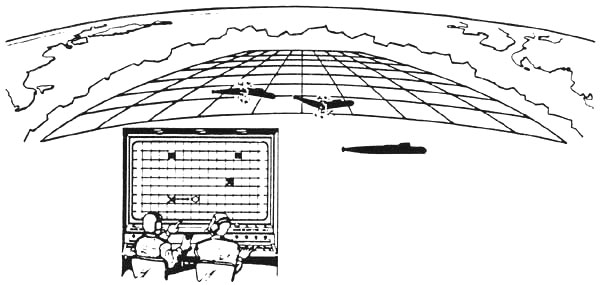
SHIFT TO ANTI-SUB MODE (UNDERWATER)
SLIDE 70

In the underwater mode portrayed on this slide, the Woodpecker transmitters have been switched to "scalar carriers" mode and the carrier beams transmitted through the ground and into the ocean underwater. (Remember, an
artificial EM potential that does not couple to charged particles or ions
will travel through the ocean, but a force field will not.)
Thus a giant scalar interference grid is now established underwater. This grid is scanned by additional scalar beams in the weakly endothermic mode. When a submarine enters the grid, it substantially changes the potential in that cell, and the scanner picks this up. The distant screen now displays the sub as a "track" of light in the appropriate grid square cell. The
computer switches in fine-scanning and non-cooperative target identification. It identifies the target as hostile and alerts the operator (by blinking the track and changing its color to red, for
example).
As before, the operator
marks the target and enters the firing mode and type of action desired. Again,
let us assume the "EMP burst" mode of destruction is to be used. The computer
computes the
firing parameters and readies the howitzer. When the commander gives the
command to fire, the operator presses the firing button. The computer fires the
howitzer.
Two scalar pulses proceed
through the howitzer scalar channel and meet in the submarine. Throughout the sub and its vicinity, a violent
EMP
is suddenly experienced, knocking out the electrical systems, electronic
equipment, and igniting propellants and explosives in the on-board missiles and armament. This explodes the submarine,
missiles, and torpedoes instantly.
At the distant command console,
the violent eruption of energy from the exploding submarine is detected by the
scanners. It appears on the screen as a sudden strong blossoming of the track.
The operator assesses that the target has been destroyed. He immediately engages
another target if one is present.
If the EMP is off-course and
misses, the scanners still pick up a smaller blossoming in the offset location. The operator
immediately knows he has missed the target. He marks the offset bloom, presses
the switch for "Correct!" and the computer makes the firing
correction. When the operator again gets a Ready-to-Fire light illuminated, he presses the firing button and fires again at
the target, this time with corrections applied.
Again, the same Woodpecker
system -- using timing, phasing, scalar/EM switching and spread-spectrum
techniques -- may be involved in several grids and many types of targets. When
in a target-rich environment, the firing operators may be very busy indeed.
As we shall later see, the same
weapon system may also be firing in the "cold explosion" or pulsed
endothermic mode, where intense bursts of instant and severe freezing are
unleashed in the target zone.